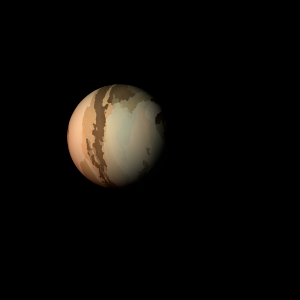|
|
Space Astro
|
Info for exoplanet "Deisida"
| Scientific (actual) data |
|---|
| Name | Kepler-1320 b |
| Planet status | Confirmed |
| Radius | 0.152 |
| Orbital period | 0.868387 |
| Discovered | 2016 |
| Updated | 2021-02-05 |
| Tconj | 2454960 |
| Publication | Announced on a website |
| Detection type | Primary Transit |
| Alternate names | 2MASS J19134406+4022511 b, K02708.01, KIC 5175986 b, KOI-2708 b, KOI-2708.01, WISE J191344.06+402250.8 b |
| Star name | Kepler-1320 |
| Right ascension | 288.43° |
| Declination | 40.38° |
| Mag j | 14.231 |
| Mag h | 13.713 |
| Mag k | 13.658 |
| Star distance | 771 |
| Star metallicity | 0.1 |
| Star mass | 0.8 |
| Star radius | 0.74 |
| Star age | 3.16 |
| Star temperature | 4817 |
| Star alternate names | 2MASS J19134406+4022511, KIC 5175986, KOI-2708, WISE J191344.06+402250.8 |
| Wikipedia article | Kepler-1320 b |
Back
| |
| Fictional info (?) |
|---|
| Suggested name | Deisida |
| Planet type | Cold planet |
| As seen relative to the fixed stars, it rotates on its axis exactly four times for every five revolutions it makes around Kepler-1320.
Having almost no atmosphere to retain heat, it has surface temperatures that vary diurnally more than on any other planet in its solar system, ranging from 130°K (-143°C) at night to 1085°K (812°C) during the day across the equatorial regions.
The outer atmosphere is visibly segregated into several bands at different latitudes, resulting in turbulence and storms along their interacting boundaries. |
| Atmosphere | Carbonyl sulfide | 77% |
| Xenon | 22% |
| Ammonia | 0.0059% |
| Atmospheric pressure | 100 bar |
 |
| No known satellites |
| Google search for Deisida |
|
Website by Joachim Michaelis
|
|
|
|